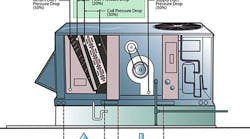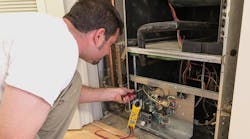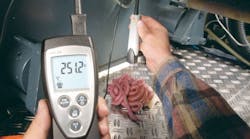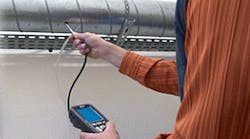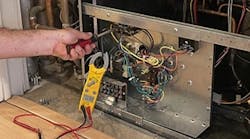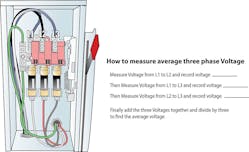In the last HVAC HotMail article, Doc described the steps required to measure single-phase voltage. Many of you wrote asking for a similar article detaining how to measure three phase voltage. So let’s take a look at the steps required to measure three-phase voltage in this article.
Safety First
If you missed the single-phase Voltage measurement article, click here to review this it and learn about important safety warnings and required test instruments needed to complete this testing. If you have not been trained in electrical safety, please do not attempt this testing until you have been properly trained and are aware of the safety requirements. Your life may depend on this training.
Where to Test
Three-phase voltage readings are typically taken at the incoming line side (typically the top) of the disconnect switch or at the line terminal that feeds power to the unit’s distribution block, contactor, relay, or motor starter. This is usually the safest test location to test voltage.
Measure Three-Phase Voltage
When taking voltage readings on a three phase piece of equipment, the voltage between each leg is measured and then averaged. Here are the steps of this test:
- Set your True RMS electrical multi-meter to read “AC” or to the V with the wavy line. Select the approximate voltage you intend to test. If measuring HVAC equipment the approximate voltage can be found in the engineering data published by the manufacturer.
- Insert the black probe into the meter’s Common (COM) port and the red probe into the Test port (Normally to the right of the common port.)
- When testing assure your hands do not come in contact with the live electrical circuit or the metal end of the probe. Touch only the plastic or insulated handles of the probe.
- When you and others are all clear, energize the equipment.
- Place the black probe on an exposed ground wire or terminal.
- Place the red probe on the left hot leg (Phase One). Read and record voltage on phase one.
- While keeping the black probe on ground, place the red probe on the second hot leg. Read and record the voltage on phase two.
- Then with your black probe still on ground, place the red probe on the third hot leg. Read and record the voltage on the third phase.
Next, Measure, and Calculate Average Voltage
Use this illustration to help you as you test three phase voltage. Note each phase or leg of three phase power is labeled L1, L2 and L3. Follow the pattern indicated as you test:
- Place your black probe on phase 1 and the red probe on phase 2. Read and record the phase to phase voltage between phase 1 and 2.
- Next, keep the black probe on phase 1 and move the red probe to phase 3. Read and record the phase to phase voltage between phase 1 and 3.
- Finally place your black probe on phase 2 and the red probe on phase 3. Read and record the phase to phase voltage between phase 2 and 3.
- Average all three legs by adding the total sum voltage of all three legs and divide by three to find the operating voltage. Record the phase to phase voltage.
- Verify all three-phase to phase voltages are within 3% of the same voltage.
Voltage measurement is one of the basic tests performed thousands of times daily across the country by HVAC professionals. Being able to accurately test and interpret readings are basic keys to the success of every technician or installer. Be safe out there.
Rob “Doc” Falke serves the industry as president of National Comfort Institute an HVAC based training company and membership organization. If you're an HVAC contractor or technician interested in a free procedure to use in the field on how to measure voltage, contact Doc at [email protected] or call him at 800-633-7058. Go to NCI’s website at nationalcomfortinstitute.com for free information, articles and downloads.
